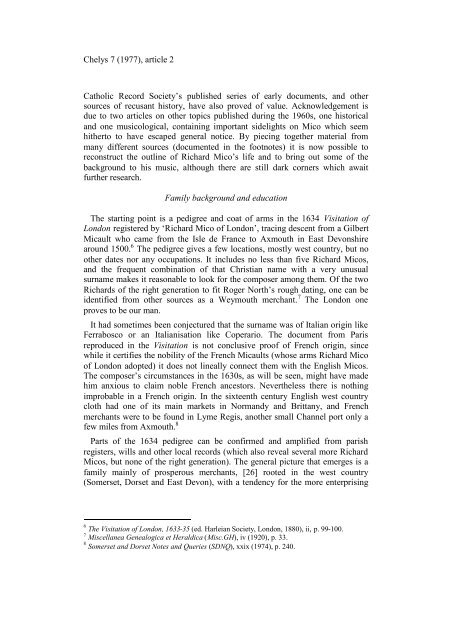download.pdf - 6.3Mb - Viola da Gamba Society
download.pdf - 6.3Mb - Viola da Gamba Society
download.pdf - 6.3Mb - Viola da Gamba Society
You also want an ePaper? Increase the reach of your titles
YUMPU automatically turns print PDFs into web optimized ePapers that Google loves.
Chelys 7 (1977), article 2<br />
Catholic Record <strong>Society</strong>’s published series of early documents, and other<br />
sources of recusant history, have also proved of value. Acknowledgement is<br />
due to two articles on other topics published during the 1960s, one historical<br />
and one musicological, containing important sidelights on Mico which seem<br />
hitherto to have escaped general notice. By piecing together material from<br />
many different sources (documented in the footnotes) it is now possible to<br />
reconstruct the outline of Richard Mico’s life and to bring out some of the<br />
background to his music, although there are still <strong>da</strong>rk corners which await<br />
further research.<br />
Family background and education<br />
The starting point is a pedigree and coat of arms in the 1634 Visitation of<br />
London registered by ‘Richard Mico of London’, tracing descent from a Gilbert<br />
Micault who came from the Isle de France to Axmouth in East Devonshire<br />
around 1500. 6 The pedigree gives a few locations, mostly west country, but no<br />
other <strong>da</strong>tes nor any occupations. It includes no less than five Richard Micos,<br />
and the frequent combination of that Christian name with a very unusual<br />
surname makes it reasonable to look for the composer among them. Of the two<br />
Richards of the right generation to fit Roger North’s rough <strong>da</strong>ting, one can be<br />
identified from other sources as a Weymouth merchant. 7 The London one<br />
proves to be our man.<br />
It had sometimes been conjectured that the surname was of Italian origin like<br />
Ferrabosco or an Italianisation like Coperario. The document from Paris<br />
reproduced in the Visitation is not conclusive proof of French origin, since<br />
while it certifies the nobility of the French Micaults (whose arms Richard Mico<br />
of London adopted) it does not lineally connect them with the English Micos.<br />
The composer’s circumstances in the 1630s, as will be seen, might have made<br />
him anxious to claim noble French ancestors. Nevertheless there is nothing<br />
improbable in a French origin. In the sixteenth century English west country<br />
cloth had one of its main markets in Normandy and Brittany, and French<br />
merchants were to be found in Lyme Regis, another small Channel port only a<br />
few miles from Axmouth. 8<br />
Parts of the 1634 pedigree can be confirmed and amplified from parish<br />
registers, wills and other local records (which also reveal several more Richard<br />
Micos, but none of the right generation). The general picture that emerges is a<br />
family mainly of prosperous merchants, [26] rooted in the west country<br />
(Somerset, Dorset and East Devon), with a tendency for the more enterprising<br />
6 The Visitation of London, 1633-35 (ed. Harleian <strong>Society</strong>, London, 1880), ii, p. 99-100.<br />
7 Miscellanea Genealogica et Heraldica (Misc.GH), iv (1920), p. 33.<br />
8 Somerset and Dorset Notes and Queries (SDNQ), xxix (1974), p. 240.
















